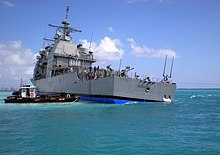USS Port Royal (CG-73)
 The Port Royal with the aircraft carriers Nimitz and Independence |
|
| Overview | |
|---|---|
| Order | February 25, 1988 |
| Keel laying | October 18, 1991 |
| Launch | November 20, 1992 |
| 1. Period of service |
|
| Commissioning | July 9, 1994 |
| Technical specifications | |
| displacement |
9750 tons |
| length |
173 meters |
| width |
16.80 meters |
| Draft |
10.2 meters |
| crew |
approx. 390 |
| drive |
Four gas turbines, two shafts together 80,000 hp |
| speed |
30+ knots |
| Armament |
2 launchers for anti-ship missiles, 2 triple torpedo launchers, 2 guns 127 mm, 122 VLS cells |
The USS Port Royal (CG-73) is a guided missile cruiser of the United States Navy and the last ship of the Ticonderoga-class cruiser .
history
construction
The ship was built at Ingalls Shipbuilding in Pascagoula , Mississippi . The ship was christened by Susan G. Baker, wife of James Baker , the name is derived from the Battle of Port Royal off Port Royal , South Carolina .
Calls
The first mission took the Port Royal with the combat group around USS Nimitz from 1995 to the Persian Gulf in support of Operation Southern Watch , and later to the Formosa Strait after China had carried out missile tests off the coast of Taiwan .
The next mission 1997-1998 led the Port Royal again in the Gulf, where they supported Southern Watch.
From 2000 the Port Royal sailed with the combat group around the USS John C. Stennis , again in support of Southern Watch. After her port side was damaged during an inspection of a cargo ship, the Port Royal had to go to dry dock, where her electronics were also replaced.
At the. November 17, 2001 she rejoined the combat group led by the John C. Stennis , with which she u. a. cruised in the Arabian Sea during the disempowerment of the Taliban regime in Afghanistan and served as escort. In 2003 and 2006, the Port Royal served as an escort for the USS Peleliu (LHA-5) , and then at the end of 2007 together with the USS Tarawa (LHA-1) . On this trip, the sailed Port Royal in early 2008 in close formation with the USS Hopper (DDG 70) and USS Ingraham (FFG-61) , the Strait of Hormuz in international waters. During the passage, the three ships were approached by five speedboats of the Iranian Revolutionary Guard , which broke into formation, transmitted threatening radio messages and exposed white boxes of unknown content in front of the Ingraham in the water. The incident lasted 30 minutes and was described by the US as "unnecessarily provocative".
In the summer of 2008, the Port Royal took part in the RIMPAC exercise, after which the ship was in the dry dock of the Pearl Harbor Naval Shipyard for a routine overhaul until early 2009 . On February 5, 2009, during the first test drives after the shipyard stay, the cruiser ran aground around 1.5 miles from the entrance to Pearl Harbor . On the following three days, the Navy tried to tow the Port Royal from the coral reef at the high tide in the early morning, but failed. It was not until February 9th, after the cruiser's water tanks had been emptied and the anchors and anchor chains removed, that eight tugs were able to tow the Port Royal free and to Pearl Harbor. Only hours later the commandant of the Port Royal was relieved.
The cruiser suffered damage to both propellers and the sonar dome in the bow when it hit the ground. Since the Port Royal was perpendicular to the waves on the reef, they rolled the ship over three days. This also damaged other drive elements - from the shafts via gearboxes to the turbines - as well as the VLS cells and radar devices on the mast. The dry dock repair took seven months, followed by further repairs and tests on the pier. Among other things, the sonar dome had to be completely replaced and the rudders and propellers repaired. The entire procedure cost around $ 40 million. In addition, the Navy had to spend $ 7 million to repair damage to the reef. At the end of 2010 the Port Royal was back in the shipyard. The superstructure of the cruiser showed cracks, as they had also appeared on other ships of the class. The Navy has placed a $ 14 million contract with BAE Systems to repair it .
On June 24, 2011, the Port Royal relocated for the first time since the accident. The journey took them to the Western Pacific and further to the Middle East as part of the National Missile Defense .
The ship was supposed to be decommissioned on March 31, 2013. The Navy later decided against it and kept the Port Royal .
Web links
- Entry in the Naval Vessel Register (Engl.)
- Official Homepage (Engl.)
Individual evidence
- ↑ Navy Times: Top admiral details US-Iranian encounter ( page no longer available , search in web archives ) Info: The link was automatically marked as defective. Please check the link according to the instructions and then remove this notice. (engl.)
- ↑ Navy Times: Navy ends reef repairs from Port Royal incident ( page no longer available , search in web archives ) Info: The link was automatically marked as defective. Please check the link according to the instructions and then remove this notice. (engl.)
- ↑ Sam Fellman: Navy budget request avoids deep cuts. NavyTimes.com, February 13, 2012, accessed April 30, 2013 .
- ↑ US Navy to retain four Ticonderoga-class cruisers in service. naval-technology.com, September 28, 2012, accessed April 30, 2013 .
